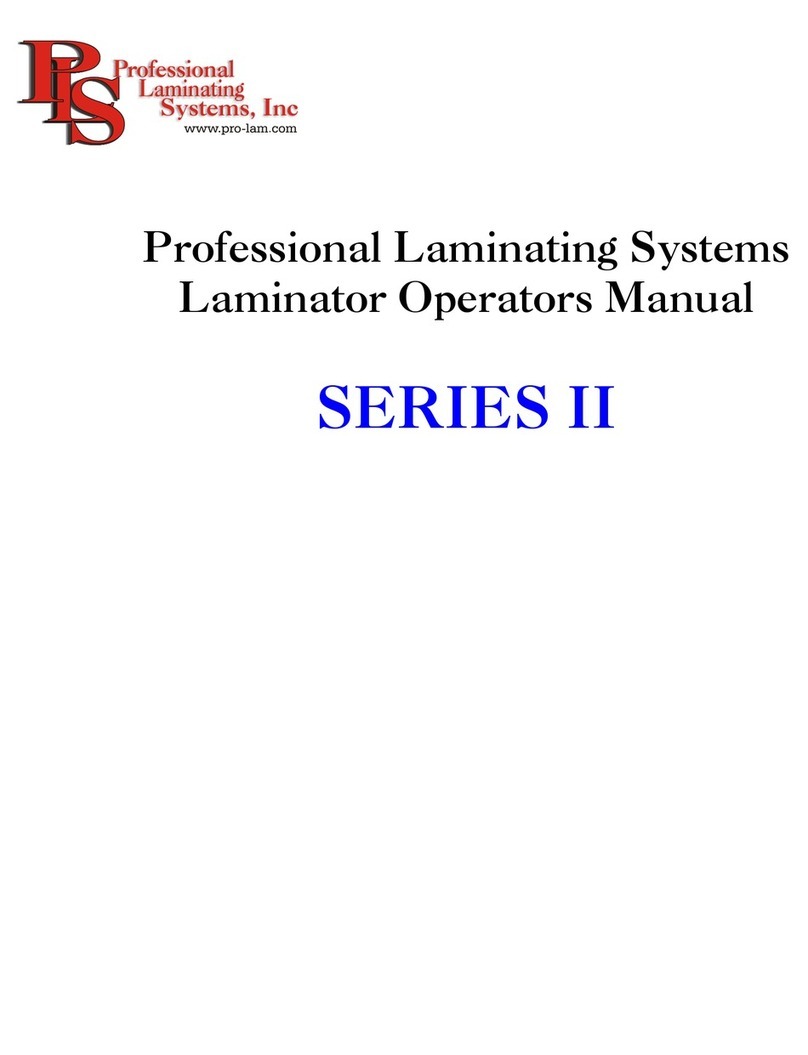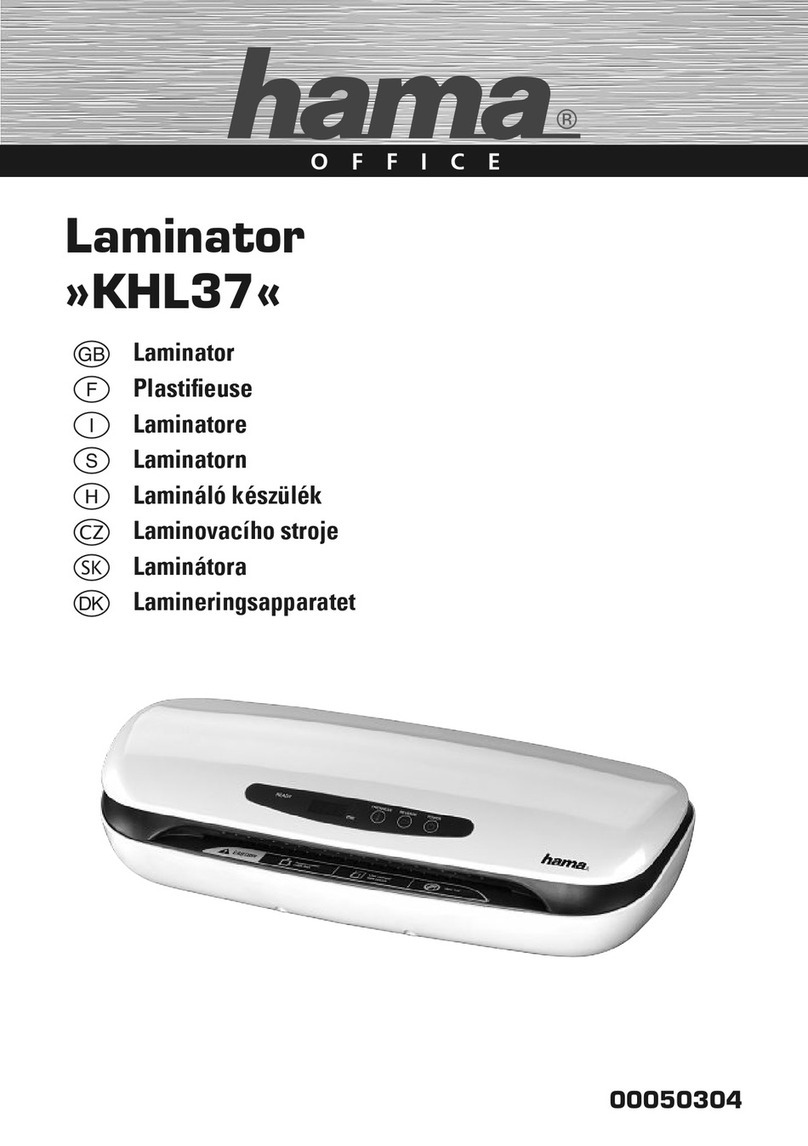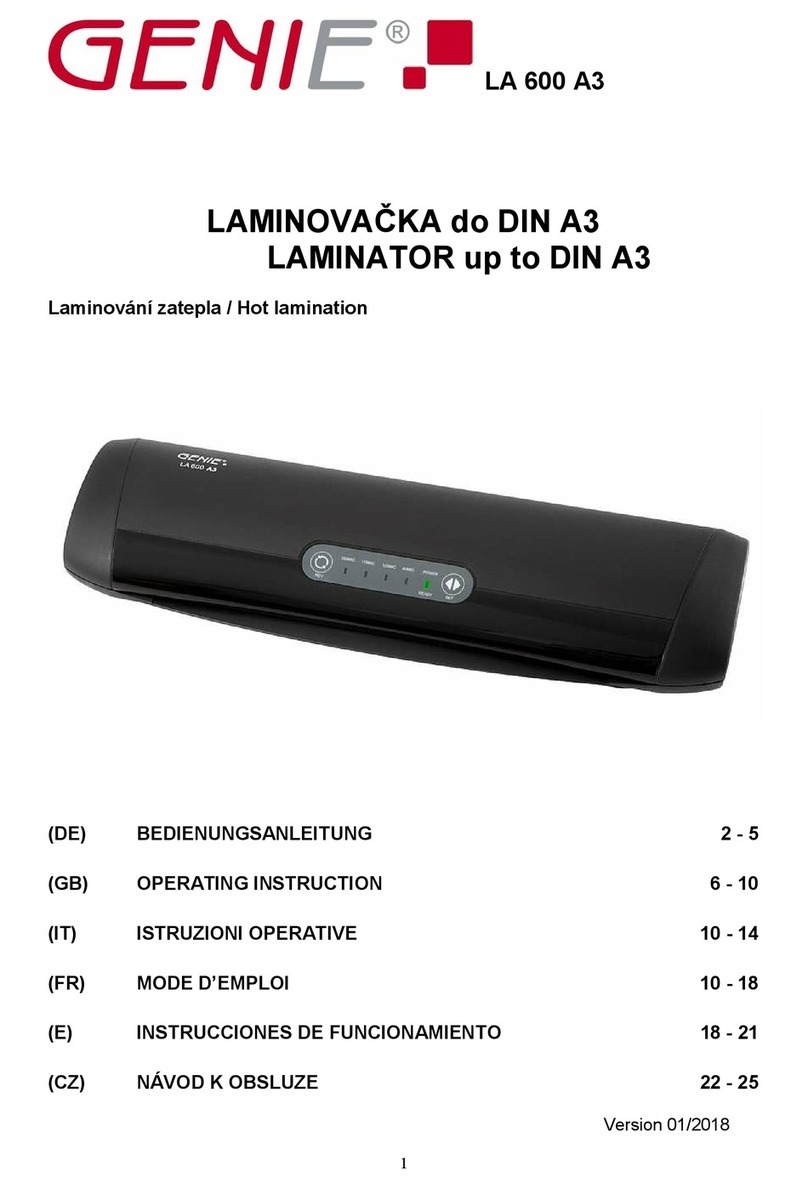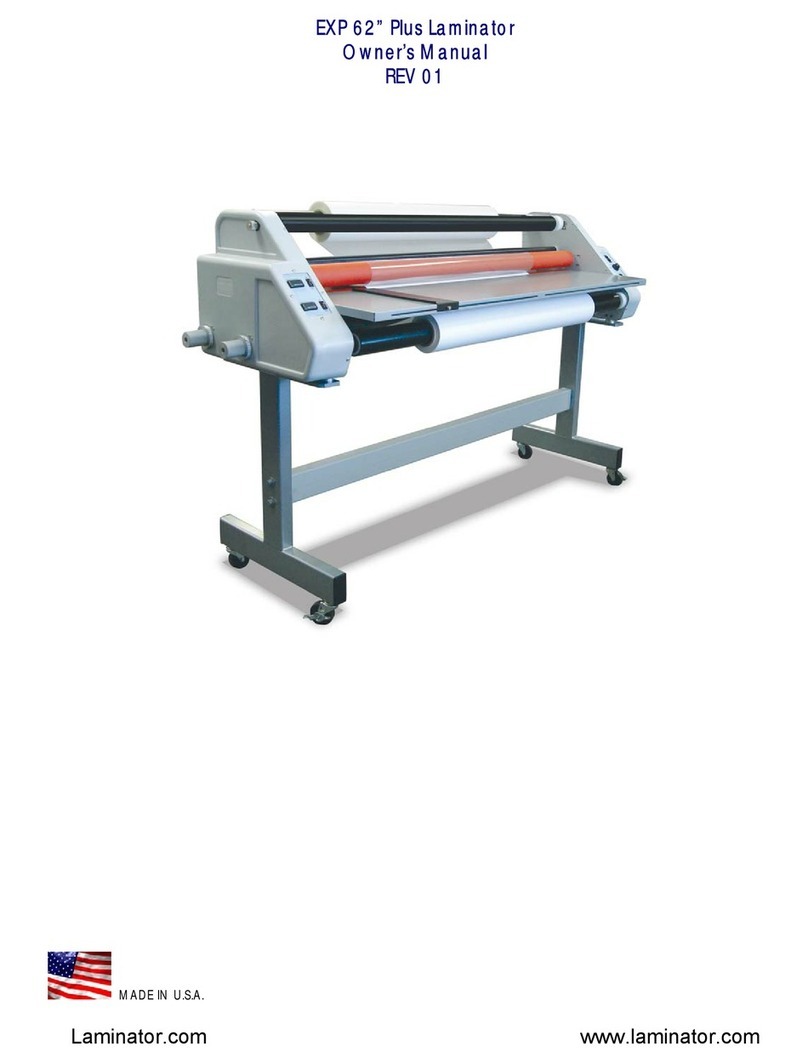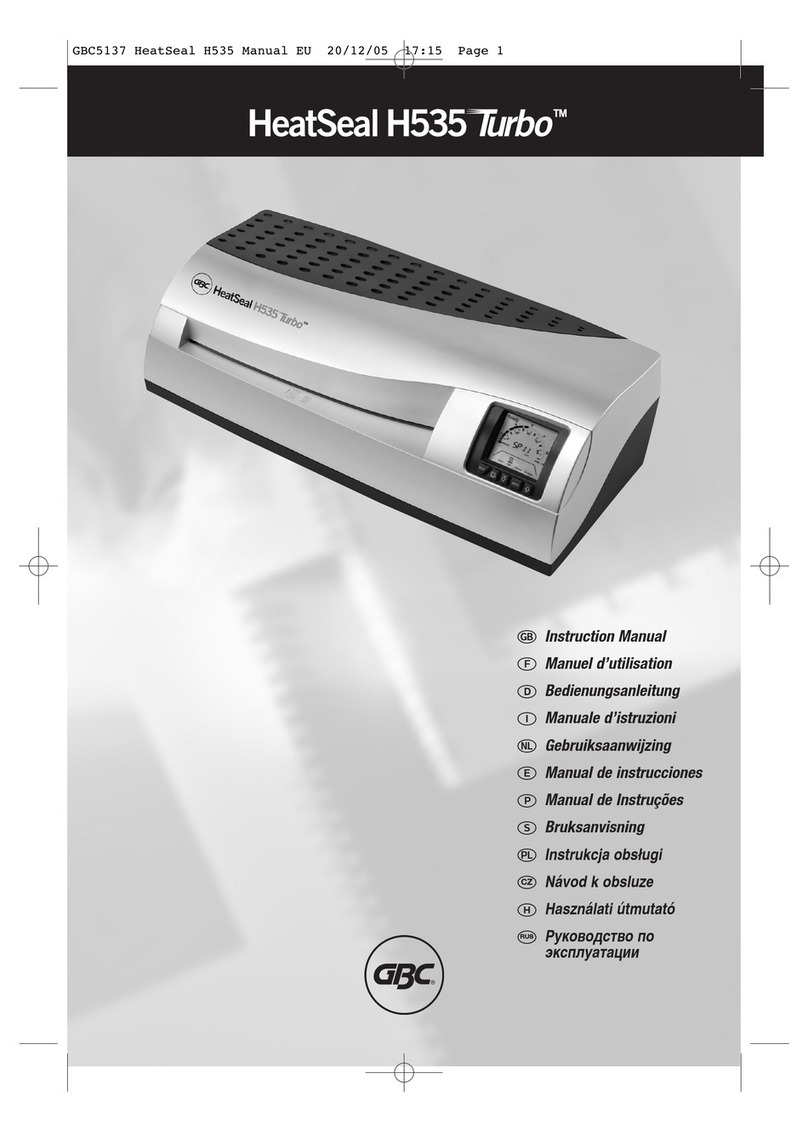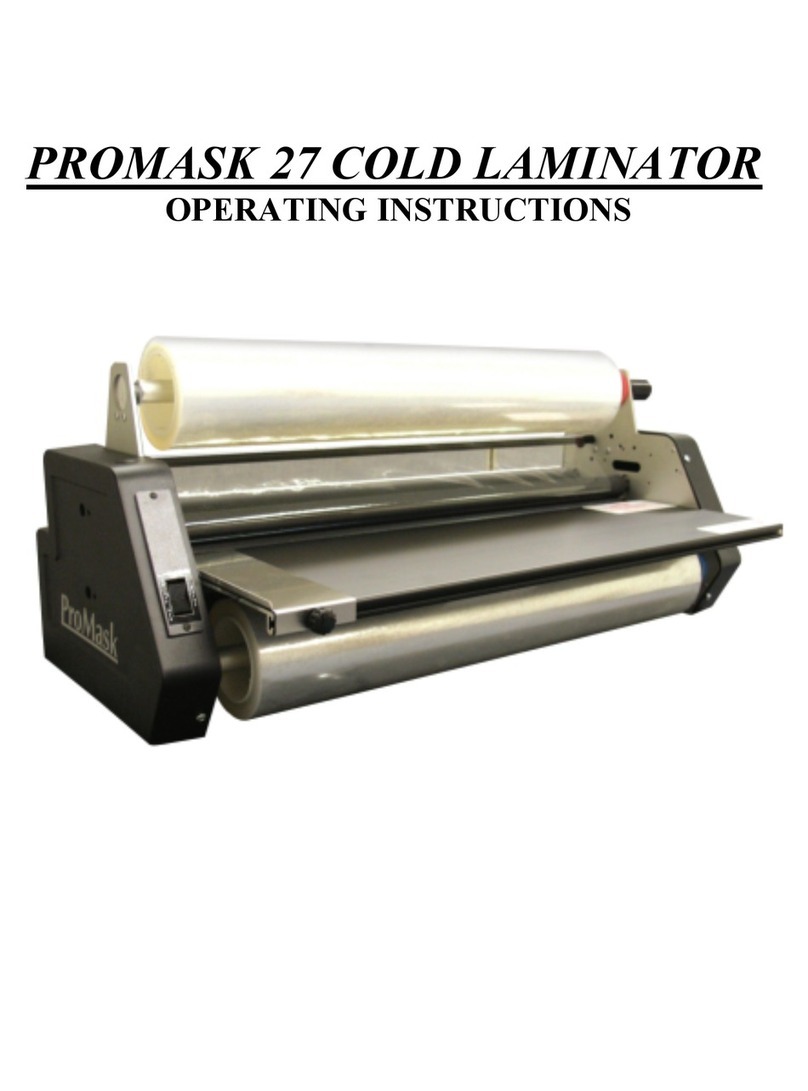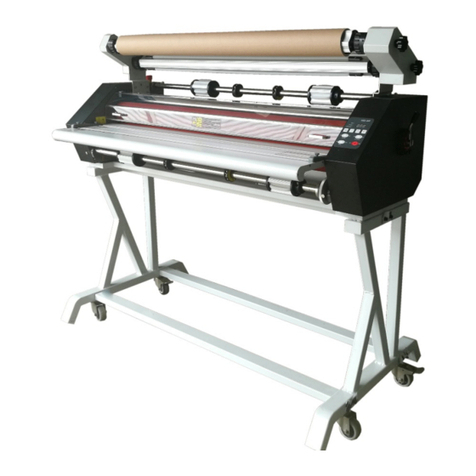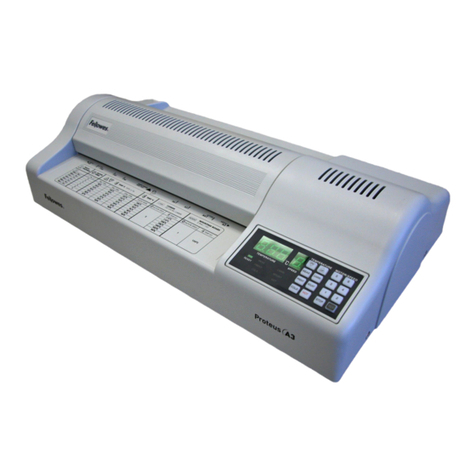Professional Laminating Systems II Series User manual

Professional Laminating Systems
Laminator Manual
SERIES II
OPERATORS MANUAL

3

4
Machine Details
Model: ____________
Serial #_______________
Date Of Purchase______________
Date Of Manufacture_______________
Voltage_______________
Inspector_______________

5
__________________________________________________________________
__________________________________________________________________
__________________________________________________________________
__________________________________________________________________
__________________________________________________________________
__________________________________________________________________
__________________________________________________________________
__________________________________________________________________
__________________________________________________________________
__________________________________________________________________
__________________________________________________________________
__________________________________________________________________
__________________________________________________________________
__________________________________________________________________
__________________________________________________________________
__________________________________________________________________
__________________________________________________________________
__________________________________________________________________
__________________________________________________________________
__________________________________________________________________
__________________________________________________________________
__________________________________________________________________
__________________________________________________________________
__________________________________________________________________
__________________________________________________________________
__________________________________________________________________
__________________________________________________________________
__________________________________________________________________
__________________________________________________________________
__________________________________________________________________
__________________________________________________________________
_____________________

6

7
1 - Basics: _____________________________________________11
#1. Feed Table ____________________________________________ 12
Feed Table Installation_____________________________ 12
Feed Table Side Guide Adjustment: __________________ 12
#2. Mandrels______________________________________________ 13
Mandrel Size:____________________________________ 13
Tension Control Knob: ____________________________ 16
#3 Laminating Roller._______________________________________ 17
#4 Gapping Handle. ________________________________________ 19
Purpose:________________________________________ 19
#5 Slitters:________________________________________________ 21
Slitter Warnings: _________________________________ 22
Slitter Setup and Operation:_________________________ 23
Changing Blades:_________________________________ 25
#6 Pressure Knob __________________________________________ 26
#2 Operator Interface: __________________________________27
#6. Temperature Control Dial_________________________________ 28
Temperature Recommendations:_____________________ 28
#7. Display _______________________________________________ 28
#8. Power Switch __________________________________________ 28
#9. Fans _________________________________________________ 29
Fan Recommendations: ____________________________ 29
#10. Motor Direction Control ________________________________ 30
#11. Motor Speed Control ___________________________________ 30
Speed Recommendations: __________________________ 30
#3 Laminator Setup_____________________________________33
Film threading fundamentals:_________________________________ 34
Film threading fundamentals:_________________________________ 34
Idler Rollers_____________________________________ 34
Threading Procedure________________________________________ 35
Threading Diagrams ________________________________________ 41
Film Tuning ______________________________________________ 43
Mandrel Tower Alignment. _________________________ 43
Adjust the mandrel tension._________________________ 44
Temperature. ____________________________________ 45
Roller pressure. __________________________________ 45
Speed. _________________________________________ 45
Film Replacement__________________________________________ 46
Film Removal ___________________________________ 47
Cleaning: _______________________________________ 48

8
Operation _____________________________________________49
General Two-sided lamination:________________________________ 49
Film Type: ______________________________________ 49
Temperature: ____________________________________ 50
Speed: _________________________________________ 51
Roller Pressure: __________________________________ 51
Fans ___________________________________________ 53
Single sided Lamination: ____________________________________ 55
One sided – general: ______________________________ 55
Board Stock: ____________________________________ 57
Cold Lamination _________________________________ 57
Shutdown ________________________________________________ 58
Maintenance___________________________________________59
Cleaning the Laminator ____________________________ 59
Roller cleaning___________________________________ 59
Rubbing pad compound____________________________ 60
Brushes ________________________________________ 60
Cleaning the Slip Ring_____________________________ 62
Cleaning the motor _______________________________ 62
Lubrication:_______________________________________________ 64
Copper Antistatic Tinsel ___________________________ 65
Roller Care And Maintenance ________________________________ 66
Operating Guidelines: _____________________________ 67
Film: __________________________________________ 67
Cleaning: _______________________________________ 67
Film Wrap ______________________________________ 69
Maintenance: ____________________________________ 69
Troubleshooting ___________________________________________ 70
Overview _______________________________________ 70
Common Errors __________________________________ 70
Glossary _________________________ Error! Bookmark not defined.
Notes____________________________________________________ 76
LIMITED WARRANTY ____________________________________ 77
CLAIM PROCEDURE______________________________________ 78
#6Conversion Tables: ___________________________________79
Temperature: Celsius to Fahrenheit ____________________________ 79
Professional Laminating Systems, Inc.
Hamilton, MT. 59840 406-363-1690

9
WARNINGS & SAFETY
DO NOT OPERATE THIS LAMINATOR WITHOUT FIRST REVIEWING THIS
OPERATORS MANUAL IN ITS ENTIRETY.
NEVER OPERATE THIS MACHINE WITH REMOVED, DAMAGED OR
MISSING PARTS - SHUTDOWN AND DISCONNECT FROM THE ELECTRICAL SUPPLY.
IF THERE WERE TO EVER BE A MECHANICAL OR ELECTRICAL MALFUNCTION
IMMEDIATELY UNPLUG THE MACHINE
NEVER SERVICE THIS MACHINE WITHOUT FIRST DISCONNECTING THE MACHINE
FROM THE ELECTRICAL SOURCE.
DO NOT TOUCH THE HEATED ROLLERS AS THEIR TEMPERATURE MAY EXCEED 350
DEGREES FAHRENHEIT.
NEVER ALLOW SHARP OBJECTS SUCH AS KNIVES OR SCISSORS TO
CONTACT THE ROLLER SURFACE AS A POTENTIAL SHOCK
HAZZARD EXISTS AS WELL AS THE POTENTIAL TO INFLICT SERIOUS AND
IRREPARABLE DAMAGE TO THE SILICONE ROLL COVERING OR THE OPERATOR.
CAUTION MUST BE EXERCISED TO KEEP HANDS FROM THE NIP POINT OF THE
LAMINATING AND PULL ROLLERS TO AVOID INJURY DUE TO HIGH PRESSURE AND
HEAT AT THESE POINTS.
FAMILIARIZE YOURSELF WITH THE REVERSE FEATURE, DO NOT WEAR LOOSE-
FITTING CLOTHING AND JEWELRY AND HAIR MUST BE PUT UP AND KEPT
AWAY FROM THE NIP POINT THESE ITEMS COULD BE PULLED INTO THE
LAMINATOR SINCE THE ROLLERS ARE ROTATING.
IF THE SLITTERS (SIDE TRIM KNIVES) ARE USED, USE EXTREME
CAUTION WHEN HANDLING THE KNIFE BLADES OR MAKING
ADJUSTMENTS AS THE KNIFE BLADES ARE RAZOR SHARP.
LEAVE REPAIRS AND MAINTENANCE TO A QUALIFIED PERSONNEL.
NEVER LEAVE THE MACHINE UNATTENDED WHILE IN USE.

10
SHUT THE MACHINE DOWN AND ALWAYS KEEP ROLLERS GAPPED WHILE THE
MACHINE IS NOT BEING ATTENDED. THIS GREATLY EXTENDS THE LIFE OF THE
ROLLERS AS WELL AS SAVING $ IN LOST ENERGY. REMEMBER YOUR NEW
LAMINATOR TAKES AS FEW AS 4 TO 5 MINUTES TO WARM UP RATHER THAN 20 OR
30
DO NOT ALLOW THE ROLLERS TO EXCEED 300 DEGREES DOING THIS WILL
GREATLY INCREASE THE LIFE OF THE LAMINATING ROLLERS – THOUGH YOUR
MACHINE IS PERFECTLY CAPABLE OF RUNNING FILM RATED AT 300 DEGREES
PRO-LAM RECOMENDS USING A FILM THAT IS RATED AT A LOWER TEMPERATURE
- THIS WILL INCREASE YOUR ROLLER LIFE
DO NOT ADVANCE THE FILM THROUGH THE LAMINATOR WHILE
THE ROLLERS ARE COLD THIS MAY RESULT IN THE SURFACE BEING TORN
FROM THE ROLLERS BY THE AGGRESSIVE LAMINATING FILM ADHESIVE.
DO NOT PLACE THE LAMINATOR NEAR ANY VENTILATION
SYSTEM AS THIS MAY COOL THE ROLLERS.
USE CARE WHEN CHANGING THE LAMINATING FILM AS THE FILM ROLLS ARE
VERY HEAVY AND MAY REQUIRE AS MANY AS 3 OR MORE PEOPLE TO LOAD THE
SUPPLY ROLLS ALSO USE CAUTION TO AVOID PINCHING HANDS OR FINGERS
WHILE LOADING THE ROLL

11
1 - Basics:
# Name Function
1 Feed tray Guides material into rollers
2 Mandrels Securely Holds laminating film
3 Laminating rollers Heats and nips the laminating film
4 Gapping handle Gaps the rollers when not in use (not shown, see
page 33)
5 Slitters Heads Cuts the excess from the side of the web of film
6 Pressure knob Adjusts the roller pressure, see section for proper
adjustment

12
#1. Feed Table
The feed table is used to correctly position the material in relation to the rollers. Located on the
surface of the Feed Table is one (or more by option) feed guide.
Feed Table Installation
1. When installing the feed table it should be held level and square in relation with the laminating
roller and with the front of the feed tray tilted as shown. 2. Slide the table forward until the pin
boss is against the pin and 3. Drop the front down so that the second pin locks the table in place.
When placing the feed table onto the laminator, always be sure that the laminator is turned
off and the rollers are stationary.
Feed Table Side Guide Adjustment:
Using a piece of paper, align the long edge of the paper to the front edge of the feed table. While
holding the paper in position, align the feed guide with the other (perpendicular) edge of the paper.
Tighten knurled knobs. This preliminary adjustment should bring the feed guides parallel to the
film path and only require very small adjustments. Run a piece of paper through while using the
slitters (see page_). Take note of the difference in the alignment of the paper from end to end and
split the difference. This should be the amount that the angle of the feed guide should be adjusted.
If the front side of the paper is too far to the right move the backside of the feed guide to the right
and vice versa.

13
#2. Mandrels
Mandrel Size:
You must match your film core size with the mandrels of your laminator
3”Mandrels:
3” Mandrels are standard equipment when the laminator is supplied with a stand. The 3” mandrel
is a unique 3” dual locking, interchangeable, ambidextrous, bidirectional mandrel. This mandrel
features a rubber roller cam that carefully locks the film roll in place, laterally and radially. In
addition, these mandrels feature ambidextrous positioning and 12”+ diameter roll capacity. The
purpose of the mandrel is to hold the film in perfect alignment with the laminator and apply a
certain amount of friction to the film core as to slow the supply of film to the machine only
enough to prevent the roll from “free spooling”. This new design does not destroy the core of your
mandrel like other designs. In addition, they feature a new locking design that provides more
lateral support than in any previous design.
If you desire to use film that is supplied with a 1” core or a 2.25” core, optional mandrels may be
available. Please contact your dealer for more information.
Film: (adhesive out)
Most 3” core film rolls are wrapped adhesive out, when mounting the film on the mandrel, you
should make sure that the film leader separates from the supply roll from the front (see film
threading, page_).
Film: (adhesive in)
Most 1” core film rolls are wrapped adhesive in, when mounting the film on the mandrel you
should make sur that the film leader separates from the supply roll from the back, (see film
threading, page_).

14
1” Mandrels:
The 1” mandrels are designed to be used with film that is wrapped adhesive in. They feature a
typical steel drive dog to grip the film, this drive dog is sharp and must not be contacted. This
drive dog only works in one direction, it is important that the film is properly installed on the
mandrels.
The clip type mandrels are marked on the end, T for the Top Mandrel, B for the Bottom. In the
center of the mandrel is a clip that holds the film core to the mandrel. If you are using 1” cored
film with the adhesive wrapped out you must use the top mandrel on the bottom and the bottom on
the top.
!!!Be very careful as the 1” mandrel clip may cut!!!
(This clip is required to hold the film supply roll tightly; the mandrels are designed to work in
only one direction so that film removal will be simplified.
1” Mandrel Clip:
Each 1-inch mandrel has one mandrel clip – use caution so that you do not cut yourself –. These
clips are located in the center of each mandrel they are designed to hold the film to the core of the
mandrel when in operation and to aid in film removal from the mandrel by allowing the core to slip
when turned in reverse. Take note when the laminator is set up if this clip is holding the mandrel to
the film core, or if it is allowing it to slip. If it is slipping, the mandrels may be in the wrong position
and should be reversed – see also installation instructions on these mandrels
1” Mandrel Clip Orientation
The following diagrams show the proper use of the 1” mandrel respective to film wrapped with the
adhesive out the intent of illustration is to demonstrate the internal operation of the mandrel clip.
As you can see in the first diagram, when the film is pulled, the core simply turns away from the
sharp edge of the mandrel clip and slips past it, in the second diagram you can see that when the
film is pulled, the core turns into the sharp edge of the mandrel clip, causing the core to “dig” into
the clip, consequently locking the core in one direction only. (the perspective of these diagrams is the top
mandrel from the right side of the machine, the bar that the film path meets is the upper idler bar)
IT IS IMPERATIVE THAT THE ADHESIVE SIDE OF THE FILM NEVER TOUCH THE
LAMINATING ROLLER

15
Installation:
The mandrels are removable and simply slip into the mandrel towers. The handle typically should
be facing the right side of the machine. It may take two people to lift the mandrel onto the
laminator because once it has a roll of film on it, it can be quite heavy.
It is a good idea to practice installing the mandrel onto the machine without any film on it so that
the process is understood. You will find that the right side will lead the left side when sliding in.
You will find that both right and left sides of the mandrel are “keyed” (the mandrel end pieces
must be turned the correct direction in order for it to drop into place into the towers)
See page_ for proper film threading directions..
Use care, when installing the mandrel, not to pinch fingers.
It is also necessary to allow the right side of the mandrel to drop into place slightly before the left
side.
Locking film to core:
Once installed into the mandrel towers on the machine, pull some film from the supply roll while
holding the core of the mandrel. This will cause the gripper to grab the core and you will feel the
film roll lock to the core, turn it by hand just a bit further and you will feel is seat in place.
If the gripping cam does not grab the film roll;
-1-Hold the film roll stationary and rotate the film core until it grabs.
-2-Clean the rubber gripping cam
-3-Replace the rubber gripping cam

16
Tension Control Knob:
The tension control knobs are located on one end of the mandrels that hold the laminating film.
They are used to:
A. Control film tension
B. Prevent the film rolls from free spooling.
C. Flatten any film curl
D. Smooth film lay on the rollers
As a rule, for the highest quality lamination, the lighter the tension, the better. The mandrel tension
may also be used to assist in keeping the lamination flat.
-If the laminate curls up when it exits the back rollers, first reduce the upper roll tension then
if necessary increase the bottom roll tension.
-If it curls down, reduce the bottom roll tension then if necessary, increase the upper roll
tension.
Please remember to use the minimum amount of tension necessary to insure a crease free and high
quality lamination.
During single sided laminations use extra attention to assure that there is zero or minimal tension on
the film, as of equal importance is an appropriate film of a high quality and in good condition.
In the event that there is excessive film wrinkling on the rollers that show on the laminate, mandrel
tension may assist in smoothing this out.
-Do not use mandrel tension to compensate for an incorrectly adjusted mandrel towers. See page_-

17
#3 Laminating Roller.
The laminating roller is the heart of the machine. The laminating roller simultaneously heats and
encapsulates the product being laminated.
We realized the need for a new technology in laminating when we were aware of the old
insurmountable limitations. We understood the need for;
-Unsurpassed thermal controllability.
-A professional quality lamination.
-Unprecedented range of materials and laminates.
-Economical to operate.
-Ease of cleaning.
-Durability.
-Extreme Warm-up times.
-Low maintenance
To achieve these goals, we developed a new patented roller that simply applies the heats to the
surface of the roller and not the entire roller assembly like other technologies.
It is very important to preserve the life of the rollers, that you follow the roller care and
maintenance instructions on page_

18

19
#4 Gapping Handle.
Purpose:
This handle is for separating the rollers when not in use or for helping to clear film wraps. The
rollers should remain in the gapped or raised position unless the machine is in operation.
(Machine shown with alternate tower, disregard differences)
Please keep the rollers in the gapped position when the machine is not in use.
By gaping the rollers, you will increase their service life as well as insuring superior laminations. If
left in the closed position for extended periods, especially when hot, you
A. Run the risk of "flat-spotting" them. This phenomenon can result in narrow bands
running from one side of the laminate to the other during every revolution of the roller.
B. Cause heat build up at the nip while the laminator is idle with the rollers heated
To ensure a quality lamination it is helpful that the rollers remain gapped and the fans off during
warm up or while the rollers are stationary for an extended period. Failure to do so may result in hot
areas on the film perpendicular to the rollers. To remedy this you need to allow the rollers to
stabilize. It is much easier to stabilize hot spots than it is to stabilize a cooled roller. To stabilize a
roller, simply allow the laminate to run through the laminator very slowly for a few revolutions of
the roller or until the hot spots disappear.

20
Operation:
Simply turn clockwise, the rollers will raise and lower with every revolution of the handle.
Gapped / Ungapped
When adjusting the roller pressures make sure that the handle is in the un-gapped position, after
making adjustments gap and ungap the rollers to make sure that you did not put too much pressure
on the rollers for the cam (gapping handle) to operate.
When gapped, you can rotate the upper rollers by hand for maintenance troubleshooting and
clearing film jams. Please be careful, as the front rollers are very hot. For more on this handle
please see page 25
The rollers must be in the closed position for successful lamination (encapsulation) to occur.
If it is found that the laminating rollers have flat spots on it due to the rollers not being gapped
simply gap the rollers and allow the laminator to go through several heating and cooling cycles and
run the laminator without film until the flat spots disappear. The silicone that we use in our rollers is
of an extremely high grade and hold nearly no memory for extended periods. We have never had one
roller returned because the rollers did not recover from not being gapped. This issue is typically just
a nuisance to the operator.

21
#5 Slitters:
# Name Description
1 Side micro
adjustment Precise edge margin adjustment
2 Adjuster lock screw Allows major movement of slitter head
3 Slitter angle and
lock Allows for angle adjustment and removal of
slitter blade holder
4 Slitter Blade holder Holds Blade
5 Spring and lubricant Holds and lubricates parts
Other manuals for II Series
1
Table of contents
Other Professional Laminating Systems Laminator manuals
Popular Laminator manuals by other brands

General Binding
General Binding Ultima 65 operating instructions
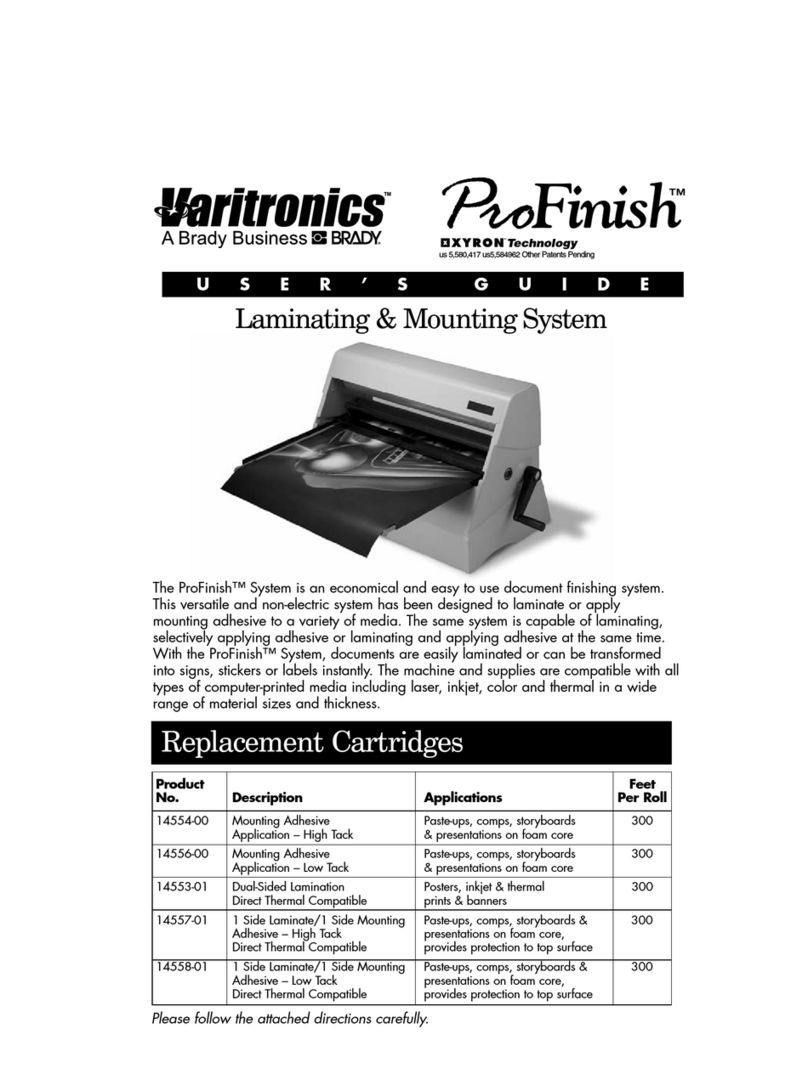
Varitronics
Varitronics 14554-00 user guide

ibico
ibico ML-4 Operation manual and warranty registration

UNITED OFFICE
UNITED OFFICE ULG 300 A1 operating instructions

Royal Sovereign
Royal Sovereign RSH-1151 Service manual
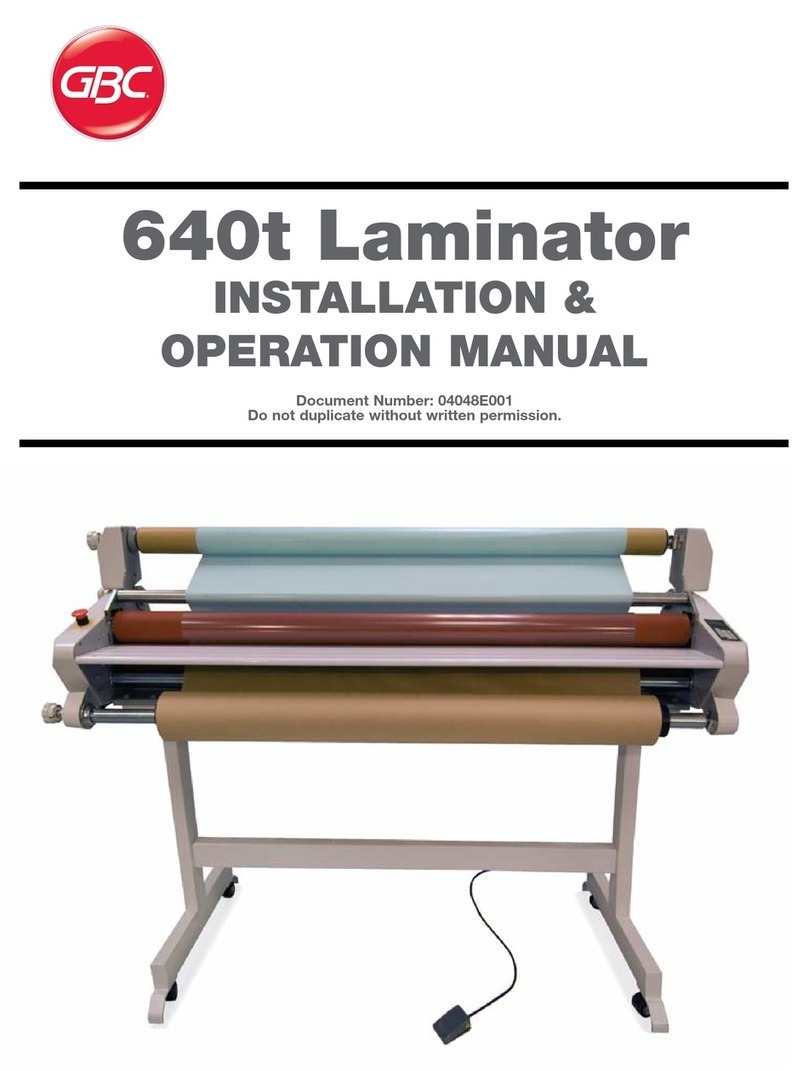
GBC
GBC 640T Installation & operation manual
